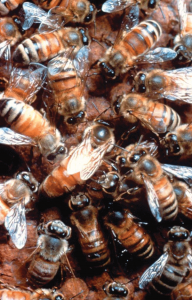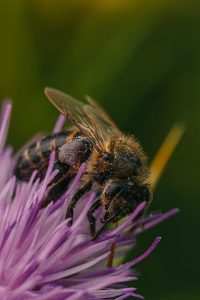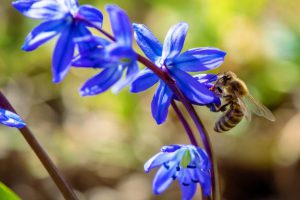Queen Rearing Behaviors
Conflict and cooperation during queen replacement.
The production of new queens is a colony level process involving the coordinated activities of hundreds or thousands of adult workers through a series of sequential stages. Honey bee queens are reared under three situations: emergency queen replacement (when the queen is lost or dies suddenly), supersedure (when the queen is old or otherwise unacceptable) and as a colony prepares for swarming (colony division). In cases of emergency queen replacement or supersedure, workers first build special queen cells from a small fraction of available worker cells with young larvae. The precise factors determining which larvae are reared as queens are unknown, but workers preferentially build queen cells from worker cells that contain brood of particular ages (Fletcher 1978; Fell and Morse 1984; Hatch et al. 1999; Tofilski and Czekonska 2004). Most queens that are raised, at least under “emergency” circumstances, originate from the oldest eggs or from the youngest larvae present at the initiation of queen earing.
AL-Kahtani and Bienefeld (2012) observed four worker behavioral patterns in the initial phase of queen rearing. First was the inspection of queen cups by nurse bees. They entered the queen cups and inspected the larvae with their antennae and mouthparts. Secondly, when worker bees were standing on the queen cups, they exposed their Nasonov glands and released Nasonov pheromone. Thirdly, fanning occurred when worker bees grasped the queen cups with their legs and started beating their wings while slightly raising their abdomen without exposing the Nasonov gland. Lastly, initiation of queen cup construction occurred when worker bees on queen cups brushed their abdominal segments with their hind legs and started chewing wax with their mandibles.
Colonies regulate queen quality traits by curtailing low-quality queens from fully developing, which is further evidence that cooperation predominates over potential conflict within honey bee colonies.
Workers determine which queen-destined brood is actually allowed to survive to adulthood. Workers frequently tear down queen cells after they have been constructed (Allen 1956; Gary and Morse 1962; Winston and Taylor 1980; Melathopoulos et al. 1996), and queen cells that are started with older brood are destroyed more often than cells initiated with eggs (Hatch et al. 1999). Given that queen reproductive potential (i.e. body size, predicted mating success, fecundity and longevity; Tarpy et al. 2011; Rangel et al. 2013) is negatively correlated with the age at which an egg or larva is initiated as a queen (Woyke 1971; Fischer and Maul 1991; Dedej et al. 1998; Gilley et al. 2003), this bias in cell destruction might suggest that workers affect the outcome of the queen-rearing process by decreasing the variation in queen traits in general, and specifically queen reproductive potential (Winston 1987).
Over the course of larval development, nurse-aged workers provide queen and worker cells with qualitatively and quantitatively different nutrition (colloquially known as “royal jelly” versus “worker jelly”; Haydak 1970; Brouwers et al. 1987), which induces divergent queen versus worker developmental trajectories. This social control of the larval nutritional environment is critically important, as demonstrated by the fact that queen-worker dimorphism disappears when social control is eliminated and larvae are reared in vitro (Linksvayer et al. 2011).
In honey bee colonies, reproduction is monopolized by the queen while her daughter workers are facultatively sterile. Caste determination is a consequence of environmental conditions during development, during which female larvae may become either queens or workers depending on their larval diet. This bipotency introduces significant variation in the reproductive potential of queen bees, with queens raised from young worker larvae exhibiting high reproductive potential and queens raised from older worker larvae exhibiting lower reproductive potential. Tarpy et al. (2011) verified that low-quality queens are indeed produced from older worker larvae, as measured morphometrically (e.g., body size) and by stored sperm counts. They also showed, for the first time, that low-quality queens mate with significantly fewer males, which significantly influences the resultant intra-colony genetic diversity of the worker force of their future colonies.
The influence of relatedness on the pre- and post-emergent survival of honey bee queens was investigated (Tarpy and Fletcher 1998). Workers did not preferentially rear sisters over non-siblings under conditions of natural queen replacement. After queen emergence, however, there was a significant effect of a queen’s relatedness to the workers on her survivorship during fights with rival queens. The mechanism of this bias towards related queens is unknown. The difference in post- emergent survivability suggests that kin selection may operate during competition among adult queens at this crucial stage of honey bee reproduction.
Tarpy et al. (2015) studied the degree to which colonies regulate adult queen traits by controlling access to developing queens that survived from pupation to adulthood. They also searched for evidence of strong conflict among patrilines (offspring from different male lines) by comparing the contribution of patrilines to new queens and new workers, although they found no evidence for the existence of significantly queen-biased patrilines or for any association between patriline contribution to new queens and queen traits. However, adult queens emerging from cells accessible to workers were larger compared to adult queens emerging from cells that were not accessible to workers. These results suggest that colonies regulate queen quality traits by curtailing low-quality queens from fully developing, which is further evidence that cooperation predominates over potential conflict within honey bee colonies.
Honey bee colonies replace their queens by constructing many queen cells and then eliminating supernumerary (in excess of normal number) queens until only one remains. The ages of the queens and the variation in their reproductive potential are important factors in the outcome of such events. Selection would favor colonies that requeen as quickly as possible to minimize the brood hiatus, therefore selecting for queens reared from older larvae. Conversely, reproductive potential (queen ‘quality’) is maximized by rearing queens from younger larvae. This potential trade-off was tested during two phases of queen replacement, queen rearing and polygyny reduction. Their results suggest that queen age is a significant element during both queen rearing and polygyny reduction, whereas queen quality, at least to the magnitude tested in this experiment, has little impact on the outcome of either process (Tarpy et al. 2000).
Honey bee colonies replace their queens by constructing many queen cells and then
eliminating supernumerary (in excess of normal number) queens until only one remains.
Queens from three feral colonies were removed and placed in separate nucleus colonies. For each colony, eggs and larvae were taken from the nucleus and placed in the main hive on each of three to four consecutive weeks. Workers in the queenless parts selected young larvae to rear as queens. Queen pupae, together with the surrounding worker pupae, were removed from each colony and analyzed at two to three microsatellite loci to determine their paternity. In all three colonies, the paternity of larvae chosen by the bees to rear as queens was not a random sample of the paternities in the worker brood, with certain subfamilies being over-represented in queens. These results support an important prediction of kin selection theory: when colonies are queenless, unequal relatedness within colonies could lead to the evolution of reproductive competition, that is some subfamilies achieving greater reproductive success than others. The mechanism by which such dominance is achieved could be through a system of kin recognition and nepotism, but they concluded that genetically based differential attractiveness of larvae for rearing as queens is more likely (Tilley and Oldroyd 1997).
Vibration Signals
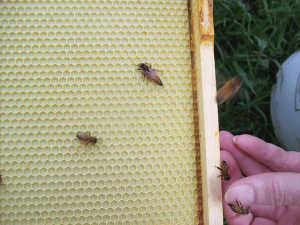 Temporary polygyny (the presence of multiple queens) occurs in honey bee colonies when virgin queens are reared for reproductive swarming or queen replacement. During these events, workers perform vibration signals on queen cells and emerged queens, and these signals may influence which virgin queen becomes the new laying queen of a colony. Schneider et al. (2001) examined the role of vibration signals during queen competition in two African and six European honey bee colonies. There was pronounced variability in vibration activity between colonies and among queens reared within the same colony. Despite this variation, all colonies showed similar trends in the relationships between the vibration signal and queen replacement. Vibration signals performed on queen cells were not associated with emergence success. Likewise, the signal was not associated with queen emergence order. Early emerging and late-emerging queens were vibrated at similar rates, and there was no clear relationship between emergence order and virgin queen survival. However, the signals performed on virgin queens after they emerged were associated with their behavior and success during the queen elimination period. Emerged virgin queens that were vibrated at higher rates survived longer, performed more bouts of piping (a characteristic sound produced by queens), eliminated more rivals and were more likely to become the new queens of the colonies. The vibration signal may therefore allow workers a degree of control over the behavior of emerged virgin queens, and may influence the outcome of queen competition in honey bees. Differences in vibration activity within and among colonies may reflect differences in the extent to which workers and queens conflict over the timing and outcome of polygyny reduction.
Temporary polygyny (the presence of multiple queens) occurs in honey bee colonies when virgin queens are reared for reproductive swarming or queen replacement. During these events, workers perform vibration signals on queen cells and emerged queens, and these signals may influence which virgin queen becomes the new laying queen of a colony. Schneider et al. (2001) examined the role of vibration signals during queen competition in two African and six European honey bee colonies. There was pronounced variability in vibration activity between colonies and among queens reared within the same colony. Despite this variation, all colonies showed similar trends in the relationships between the vibration signal and queen replacement. Vibration signals performed on queen cells were not associated with emergence success. Likewise, the signal was not associated with queen emergence order. Early emerging and late-emerging queens were vibrated at similar rates, and there was no clear relationship between emergence order and virgin queen survival. However, the signals performed on virgin queens after they emerged were associated with their behavior and success during the queen elimination period. Emerged virgin queens that were vibrated at higher rates survived longer, performed more bouts of piping (a characteristic sound produced by queens), eliminated more rivals and were more likely to become the new queens of the colonies. The vibration signal may therefore allow workers a degree of control over the behavior of emerged virgin queens, and may influence the outcome of queen competition in honey bees. Differences in vibration activity within and among colonies may reflect differences in the extent to which workers and queens conflict over the timing and outcome of polygyny reduction.
The different vibration rates experienced by virgin queens within the same colony suggest that workers preferentially direct their signaling activity towards certain queens. Such discriminations could be based on cues that reflect relatedness (Tarpy and Fletcher 1998), reproductive capacities (Tarpy et al. 2000), or virgin queen size and fighting ability (Grooters 1987; Bernasconi et al. 2000).
Queen Replacement
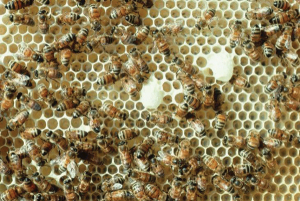 The extended phenotype of a social insect colony enables selection to act at both the individual level (within-colony selection) and the colony level (between-colony selection). Whether a particular trait persists over time depends on the relative within- and between-colony selection pressures. Queen replacement in honey bee colonies exemplifies how selection may act at these different levels in opposing directions. Normally, a honey bee colony has only one queen, but a colony rears many new queens during the process of colony reproduction. The replacement of the mother queen has two distinct phases: queen rearing, where many queens develop and emerge from their cells, and queen elimination, where most queens die in a series of fatal duels. Which queens are reared to adulthood and which queens ultimately survive the elimination process depends on the strength and direction of selection at both the individual and colony levels. If within-colony selection is predominant, then conflict is expected to occur among nestmates over which queens are produced. If between-colony selection is predominant, then cooperation is expected among nestmates. Tarpy et al. (2004) reviewed the current evidence for conflict and cooperation during queen replacement in honey bees during both the queen rearing and queen elimination phases. In particular, they examined whether workers of different subfamilies exhibit conflict by acting nepotistically toward queens before and after they have emerged from their cells, and whether workers exhibit cooperation by collectively producing queens of high reproductive quality. They concluded that although workers may weakly compete through nepotism during queen rearing, workers largely cooperate to raise queens of similar reproductive potential so that any queen is suitable to inherit the nest. Thus it appears that potential conflict over queen replacement in honey bees has not translated into actual conflict, suggesting that between-colony selection predominates during these important events in a colony’s life cycle.
The extended phenotype of a social insect colony enables selection to act at both the individual level (within-colony selection) and the colony level (between-colony selection). Whether a particular trait persists over time depends on the relative within- and between-colony selection pressures. Queen replacement in honey bee colonies exemplifies how selection may act at these different levels in opposing directions. Normally, a honey bee colony has only one queen, but a colony rears many new queens during the process of colony reproduction. The replacement of the mother queen has two distinct phases: queen rearing, where many queens develop and emerge from their cells, and queen elimination, where most queens die in a series of fatal duels. Which queens are reared to adulthood and which queens ultimately survive the elimination process depends on the strength and direction of selection at both the individual and colony levels. If within-colony selection is predominant, then conflict is expected to occur among nestmates over which queens are produced. If between-colony selection is predominant, then cooperation is expected among nestmates. Tarpy et al. (2004) reviewed the current evidence for conflict and cooperation during queen replacement in honey bees during both the queen rearing and queen elimination phases. In particular, they examined whether workers of different subfamilies exhibit conflict by acting nepotistically toward queens before and after they have emerged from their cells, and whether workers exhibit cooperation by collectively producing queens of high reproductive quality. They concluded that although workers may weakly compete through nepotism during queen rearing, workers largely cooperate to raise queens of similar reproductive potential so that any queen is suitable to inherit the nest. Thus it appears that potential conflict over queen replacement in honey bees has not translated into actual conflict, suggesting that between-colony selection predominates during these important events in a colony’s life cycle.
When colonies are queenless, unequal relatedness within colonies could lead to the evolution of reproductive competition, that is some subfamilies achieving greater reproductive success than others.
Long et al. (2017) investigated the different levels of selection that may influence the queen replacement process in honey bees by monitoring queen-queen and worker-queen interactions in queenless observation colonies containing populations of paint-marked workers that were either related or not related to introduced virgin queens experimentally reared to be of low- and high-quality, as estimated by differences in size and potential reproductive capacities. The high-quality queens were more likely to survive and become the new laying queen of their colonies. Queen survival was positively associated with both queen fighting ability and worker-queen interactions. Surviving queens were more aggressive and had greater fighting success. However, surviving queens were not bigger than killed queens nor were they the first queens to emerge, suggesting that queen size and early emergence alone are not the determining factors of queen fighting ability. The worker-queen interaction that was most strongly associated with the outcome of queen replacement was the vibration signal, which is a communication signal that workers perform on virgin queens. Surviving queens were vibrated at rates three or four times those experienced by killed queens and a queen’s vibration rate was positively correlated with her fighting ability and the number of rivals killed. Workers showed no consistent preferences for related vs. unrelated queens and the proportion of interactions received from related workers was not associated with any aspect of queen fighting ability and success monitored. Their results suggest that caste interactions during queen replacement have been shaped by both selection acting at the level of the individual queen (which favors higher quality queens with greater fighting ability) and selection acting at the level of the colony (which favors workers directing vibration signals towards queens with greater fighting potential), ultimately resulting in a higher quality queen becoming the new laying queen of the colony. Selection acting at the level of the individual worker through kin selection, which would favor preferential treatment of related queens, did not consistently influence caste interactions or the outcome of the replacement process. Thus, the outcome of queen replacement in honey bees may be determined primarily by a combination of a queen’s inherent fighting ability coupled with the rate at which she receives some interactions (particularly vibration signals) from workers.
References
AL-Kahtani, S.N. and K. Bienefeld 2012. The Nasonov gland pheromone is involved in recruiting honeybee workers for individual larvae to be reared as queens. J. Insect Behav. 25: 392-400.
Allen, M.D. 1956. The behavior of honeybees preparing to swarm. Brit. J. Anim. Behav. 4: 14-22.
Bernasconi, G., F.L.W. Ratnieks and E. Rand 2000. Effect of “spraying” by fighting honey bee queens (Apis mellifera L.) on the temporal structure of fights. Insect. Soc. 47: 21-26.
Brouwers, E.V.M., R. Ebert and J. Beetsma 1987. Behavioural and physiological aspects of nurse bees in relation to the composition of larval food during caste differentiation in the honeybee. J. Apic. Res. 26: 11-23.
Dedej, S., K. Hartfelder, P. Aumeier, P. Rosenkranz and W. Engels 1998. Caste determination is a sequential process: effect of larval age at grafting on ovariole number, hind leg size and cephalic volatiles in the honey bee (Apis mellifera carnica). J. Apic. Res. 37: 183-190.
Fell, R.D. and R.A. Morse 1984. Emergency queen cell production in the honey bee colony. Insect. Soc. 31: 221-237.
Fischer, F. and V. Maul 1991. An inquiry into the characteristics of queens depending on queen rearing. Apidologie 22: 444-446.
Fletcher, D.J.C. 1978. Vibration of queen cells by worker honeybees and its relation to the issue of swarms with virgin queens. J. Apic. Res. 17: 14-26.
Gary, N.E. and R.A. Morse 1962. The events following queen cell construction in honeybee colonies. J. Apic. Res. 1: 3-5.
Gilley, D.C., D.R. Tarpy and B.B. Land 2003. The effect of queen quality on the interactions of workers and dueling queen honey bees (Apis mellifera L.) Behav. Ecol. Sociobiol. 55: 190-196.
Grooters, H.J. 1987. Influences of queen piping and worker behaviour on the timing of the emergence of honey bee queens. Insect. Soc. 34: 181-193.
Hatch, S., D.R. Tarpy and D.J.C. Fletcher 1999. Worker regulation of emergency queen rearing in honey bee colonies and the resultant variation in queen quality. Insect. Soc. 46: 372-377.
Haydak, M.H. 1970. Honey bee nutrition. Ann. Rev. Entomol. 15: 143-156.
Linksvayer, T.A., O. Kaftanoglu, E. Akyol, S. Blatch, G.V. Amdam and R.E. Page, Jr. 2011. Larval and nurse worker control of developmental plasticity and the evolution of honey bee queen-worker dimorphism. J. Evol. Biol. 24: 1939-1948.
Long, K., T.T. Cao, J.J. Keller, D.R. Tarpy, M. Shin and S.S. Schneider 2017. Levels of selection shaping caste interactions during queen replacement in the honey bee, Apis mellifera. Insect. Soc. (In Press)
Melathopoulos, A.P., M.L. Winston, J.S. Pettis and T. Pankiw 1996. Effect of queen mandibular pheromone on initiation and maintenance of queen cells in the honey bee (Apis mellifera L.) Can. Entomol. 128: 263-272.
Rangel, J., J.J. Keller and D.R. Tarpy 2013. The effects of honey bee (Apis mellifera L.) queen reproductive potential on colony growth. Insect. Soc. 60: 65-73.
Schneider, S.S., S. Painter-Kurt and G. DeGrandi-Hoffman 2001. The role of the vibration signal during queen competition in colonies of the honeybee, Apis mellifera. Anim. Behav. 61: 1173-1180.
Tarpy, D.R. and D.J.C. Fletcher 1998. Effects of relatedness on queen competition within honey bee colonies. Anim. Behav. 55: 537-543.
Tarpy, D.R., S. Hatch and D.J.C. Fletcher 2000. The influence of queen age and quality during queen replacement in honeybee colonies. Anim. Behav. 59: 97-101.
Tarpy, D.R., D.C. Gilley and T.D. Seeley 2004. Levels of selection in a social insect: a review of conflict and cooperation during honey bee (Apis mellifera) queen replacement. Behav. Ecol. Sociobiol. 55: 513-523.
Tarpy, D.R., J.J. Keller, J.R. Caren and D.A. Delaney 2011. Experimentally induced variation in the physical reproductive potential and mating success in honey bee queens. Insect. Soc. 58: 569-574.
Tarpy, D.R., M. Simone-Finstrom and T.A. Linksvayer 2015. Honey bee colonies regulate queen reproductive traits by controlling which queens survive to adulthood. Insect. Soc. doi: 10.1007s00040-15-0452-0.
Tilley, C.A. and B.P Oldroyd 1997. Unequal subfamily proportions among honey bee queen and worker brood. Anim. Behav. 54: 1483-1490.
Tofilski, A. and K. Czekonska 2004. Emergency queen rearing in honeybee colonies with brood of known age. Apidologie 35: 275-282.
Winston, M.L. 1987. The Biology Of The Honey Bee. Harvard University Press, Cambridge, MA, 281 pp.
Winston, M.L. and O.R. Taylor 1980. Factors preceding queen rearing in the Africanized honeybee (Apis mellifera) in South America. Insect. Soc. 27: 289-304.
Wyoke, J. 1971. Correlations between the age at which honeybee brood was grafted, characteristics of the resultant queens, and results of insemination. J. Apic. Res. 10: 45-55.
Clarence Collison is an Emeritus Professor of Entomology and Department Head Emeritus of Entomology and Plant Pathology at Mississippi State University, Mississippi State, MS.








